Hanli Wang
Structural Similarity-Inspired Unfolding for Lightweight Image Super-Resolution
Jun 13, 2025Abstract:Major efforts in data-driven image super-resolution (SR) primarily focus on expanding the receptive field of the model to better capture contextual information. However, these methods are typically implemented by stacking deeper networks or leveraging transformer-based attention mechanisms, which consequently increases model complexity. In contrast, model-driven methods based on the unfolding paradigm show promise in improving performance while effectively maintaining model compactness through sophisticated module design. Based on these insights, we propose a Structural Similarity-Inspired Unfolding (SSIU) method for efficient image SR. This method is designed through unfolding an SR optimization function constrained by structural similarity, aiming to combine the strengths of both data-driven and model-driven approaches. Our model operates progressively following the unfolding paradigm. Each iteration consists of multiple Mixed-Scale Gating Modules (MSGM) and an Efficient Sparse Attention Module (ESAM). The former implements comprehensive constraints on features, including a structural similarity constraint, while the latter aims to achieve sparse activation. In addition, we design a Mixture-of-Experts-based Feature Selector (MoE-FS) that fully utilizes multi-level feature information by combining features from different steps. Extensive experiments validate the efficacy and efficiency of our unfolding-inspired network. Our model outperforms current state-of-the-art models, boasting lower parameter counts and reduced memory consumption. Our code will be available at: https://github.com/eezkni/SSIU
A Birotation Solution for Relative Pose Problems
May 04, 2025Abstract:Relative pose estimation, a fundamental computer vision problem, has been extensively studied for decades. Existing methods either estimate and decompose the essential matrix or directly estimate the rotation and translation to obtain the solution. In this article, we break the mold by tackling this traditional problem with a novel birotation solution. We first introduce three basis transformations, each associated with a geometric metric to quantify the distance between the relative pose to be estimated and its corresponding basis transformation. Three energy functions, designed based on these metrics, are then minimized on the Riemannian manifold $\mathrm{SO(3)}$ by iteratively updating the two rotation matrices. The two rotation matrices and the basis transformation corresponding to the minimum energy are ultimately utilized to recover the relative pose. Extensive quantitative and qualitative evaluations across diverse relative pose estimation tasks demonstrate the superior performance of our proposed birotation solution. Source code, demo video, and datasets will be available at \href{https://mias.group/birotation-solution}{mias.group/birotation-solution} upon publication.
HisTrackMap: Global Vectorized High-Definition Map Construction via History Map Tracking
Mar 10, 2025



Abstract:As an essential component of autonomous driving systems, high-definition (HD) maps provide rich and precise environmental information for auto-driving scenarios; however, existing methods, which primarily rely on query-based detection frameworks to directly model map elements or implicitly propagate queries over time, often struggle to maintain consistent temporal perception outcomes. These inconsistencies pose significant challenges to the stability and reliability of real-world autonomous driving and map data collection systems. To address this limitation, we propose a novel end-to-end tracking framework for global map construction by temporally tracking map elements' historical trajectories. Firstly, instance-level historical rasterization map representation is designed to explicitly store previous perception results, which can control and maintain different global instances' history information in a fine-grained way. Secondly, we introduce a Map-Trajectory Prior Fusion module within this tracking framework, leveraging historical priors for tracked instances to improve temporal smoothness and continuity. Thirdly, we propose a global perspective metric to evaluate the quality of temporal geometry construction in HD maps, filling the gap in current metrics for assessing global geometric perception results. Substantial experiments on the nuScenes and Argoverse2 datasets demonstrate that the proposed method outperforms state-of-the-art (SOTA) methods in both single-frame and temporal metrics. our project page: $\href{https://yj772881654.github.io/HisTrackMap/}{https://yj772881654.github.io/HisTrackMap.}$
Generative Planning with 3D-vision Language Pre-training for End-to-End Autonomous Driving
Jan 15, 2025



Abstract:Autonomous driving is a challenging task that requires perceiving and understanding the surrounding environment for safe trajectory planning. While existing vision-based end-to-end models have achieved promising results, these methods are still facing the challenges of vision understanding, decision reasoning and scene generalization. To solve these issues, a generative planning with 3D-vision language pre-training model named GPVL is proposed for end-to-end autonomous driving. The proposed paradigm has two significant aspects. On one hand, a 3D-vision language pre-training module is designed to bridge the gap between visual perception and linguistic understanding in the bird's eye view. On the other hand, a cross-modal language model is introduced to generate holistic driving decisions and fine-grained trajectories with perception and navigation information in an auto-regressive manner. Experiments on the challenging nuScenes dataset demonstrate that the proposed scheme achieves excellent performances compared with state-of-the-art methods. Besides, the proposed GPVL presents strong generalization ability and real-time potential when handling high-level commands in various scenarios. It is believed that the effective, robust and efficient performance of GPVL is crucial for the practical application of future autonomous driving systems. Code is available at https://github.com/ltp1995/GPVL
MGMapNet: Multi-Granularity Representation Learning for End-to-End Vectorized HD Map Construction
Oct 10, 2024
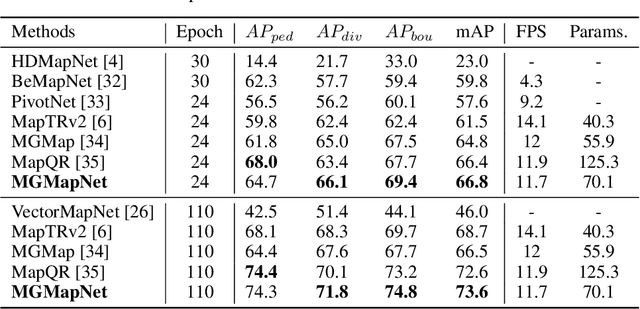
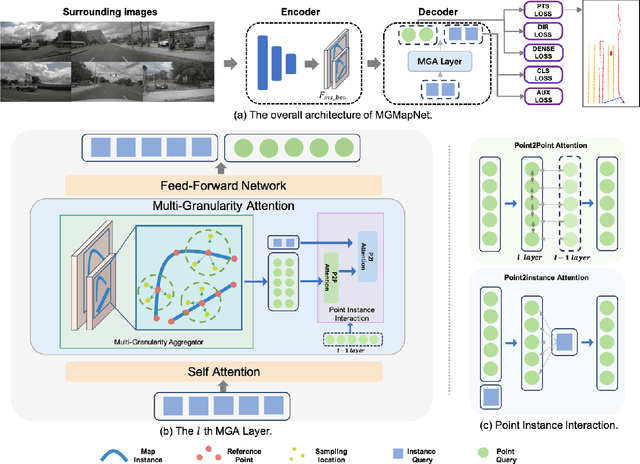

Abstract:The construction of Vectorized High-Definition (HD) map typically requires capturing both category and geometry information of map elements. Current state-of-the-art methods often adopt solely either point-level or instance-level representation, overlooking the strong intrinsic relationships between points and instances. In this work, we propose a simple yet efficient framework named MGMapNet (Multi-Granularity Map Network) to model map element with a multi-granularity representation, integrating both coarse-grained instance-level and fine-grained point-level queries. Specifically, these two granularities of queries are generated from the multi-scale bird's eye view (BEV) features using a proposed Multi-Granularity Aggregator. In this module, instance-level query aggregates features over the entire scope covered by an instance, and the point-level query aggregates features locally. Furthermore, a Point Instance Interaction module is designed to encourage information exchange between instance-level and point-level queries. Experimental results demonstrate that the proposed MGMapNet achieves state-of-the-art performance, surpassing MapTRv2 by 5.3 mAP on nuScenes and 4.4 mAP on Argoverse2 respectively.
Bootstrapping Vision-language Models for Self-supervised Remote Physiological Measurement
Jul 11, 2024Abstract:Facial video-based remote physiological measurement is a promising research area for detecting human vital signs (e.g., heart rate, respiration frequency) in a non-contact way. Conventional approaches are mostly supervised learning, requiring extensive collections of facial videos and synchronously recorded photoplethysmography (PPG) signals. To tackle it, self-supervised learning has recently gained attentions; due to the lack of ground truth PPG signals, its performance is however limited. In this paper, we propose a novel self-supervised framework that successfully integrates the popular vision-language models (VLMs) into the remote physiological measurement task. Given a facial video, we first augment its positive and negative video samples with varying rPPG signal frequencies. Next, we introduce a frequency-oriented vision-text pair generation method by carefully creating contrastive spatio-temporal maps from positive and negative samples and designing proper text prompts to describe their relative ratios of signal frequencies. A pre-trained VLM is employed to extract features for these formed vision-text pairs and estimate rPPG signals thereafter. We develop a series of generative and contrastive learning mechanisms to optimize the VLM, including the text-guided visual map reconstruction task, the vision-text contrastive learning task, and the frequency contrastive and ranking task. Overall, our method for the first time adapts VLMs to digest and align the frequency-related knowledge in vision and text modalities. Extensive experiments on four benchmark datasets demonstrate that it significantly outperforms state of the art self-supervised methods.
DDR: Exploiting Deep Degradation Response as Flexible Image Descriptor
Jun 12, 2024


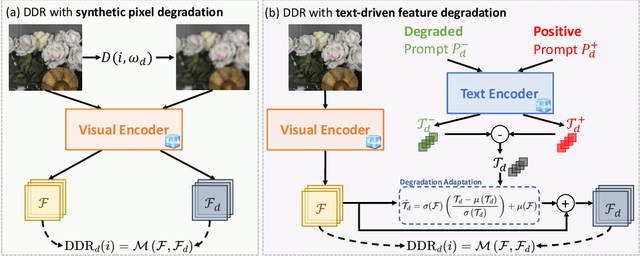
Abstract:Image deep features extracted by pre-trained networks are known to contain rich and informative representations. In this paper, we present Deep Degradation Response (DDR), a method to quantify changes in image deep features under varying degradation conditions. Specifically, our approach facilitates flexible and adaptive degradation, enabling the controlled synthesis of image degradation through text-driven prompts. Extensive evaluations demonstrate the versatility of DDR as an image descriptor, with strong correlations observed with key image attributes such as complexity, colorfulness, sharpness, and overall quality. Moreover, we demonstrate the efficacy of DDR across a spectrum of applications. It excels as a blind image quality assessment metric, outperforming existing methodologies across multiple datasets. Additionally, DDR serves as an effective unsupervised learning objective in image restoration tasks, yielding notable advancements in image deblurring and single-image super-resolution. Our code will be made available.
Opinion-Unaware Blind Image Quality Assessment using Multi-Scale Deep Feature Statistics
May 29, 2024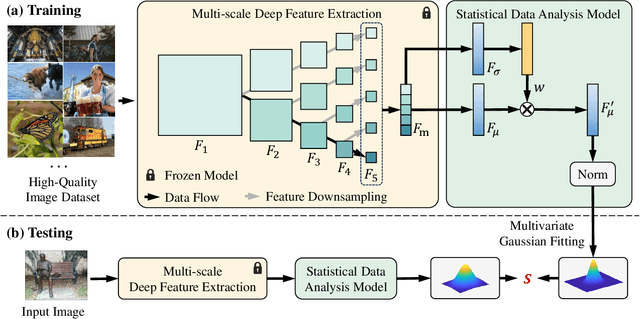
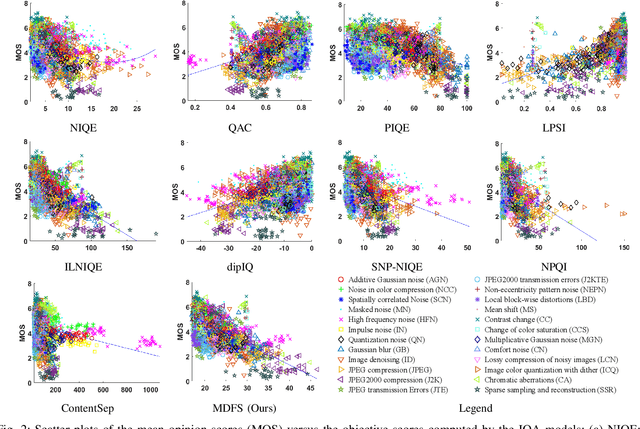

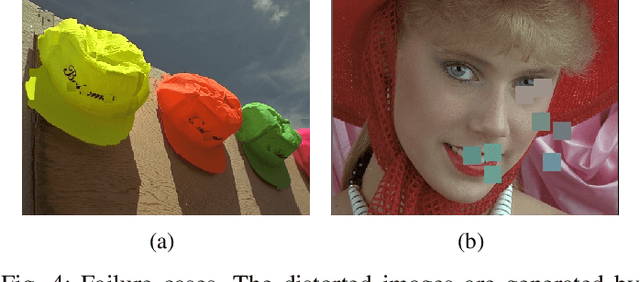
Abstract:Deep learning-based methods have significantly influenced the blind image quality assessment (BIQA) field, however, these methods often require training using large amounts of human rating data. In contrast, traditional knowledge-based methods are cost-effective for training but face challenges in effectively extracting features aligned with human visual perception. To bridge these gaps, we propose integrating deep features from pre-trained visual models with a statistical analysis model into a Multi-scale Deep Feature Statistics (MDFS) model for achieving opinion-unaware BIQA (OU-BIQA), thereby eliminating the reliance on human rating data and significantly improving training efficiency. Specifically, we extract patch-wise multi-scale features from pre-trained vision models, which are subsequently fitted into a multivariate Gaussian (MVG) model. The final quality score is determined by quantifying the distance between the MVG model derived from the test image and the benchmark MVG model derived from the high-quality image set. A comprehensive series of experiments conducted on various datasets show that our proposed model exhibits superior consistency with human visual perception compared to state-of-the-art BIQA models. Furthermore, it shows improved generalizability across diverse target-specific BIQA tasks. Our code is available at: https://github.com/eezkni/MDFS
Misalignment-Robust Frequency Distribution Loss for Image Transformation
Feb 28, 2024Abstract:This paper aims to address a common challenge in deep learning-based image transformation methods, such as image enhancement and super-resolution, which heavily rely on precisely aligned paired datasets with pixel-level alignments. However, creating precisely aligned paired images presents significant challenges and hinders the advancement of methods trained on such data. To overcome this challenge, this paper introduces a novel and simple Frequency Distribution Loss (FDL) for computing distribution distance within the frequency domain. Specifically, we transform image features into the frequency domain using Discrete Fourier Transformation (DFT). Subsequently, frequency components (amplitude and phase) are processed separately to form the FDL loss function. Our method is empirically proven effective as a training constraint due to the thoughtful utilization of global information in the frequency domain. Extensive experimental evaluations, focusing on image enhancement and super-resolution tasks, demonstrate that FDL outperforms existing misalignment-robust loss functions. Furthermore, we explore the potential of our FDL for image style transfer that relies solely on completely misaligned data. Our code is available at: https://github.com/eezkni/FDL
ColNeRF: Collaboration for Generalizable Sparse Input Neural Radiance Field
Dec 15, 2023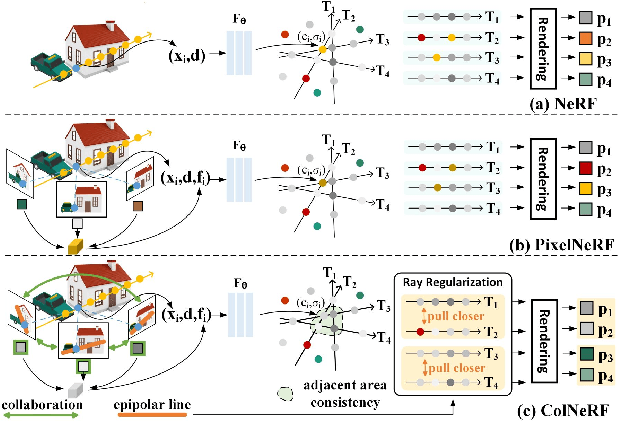



Abstract:Neural Radiance Fields (NeRF) have demonstrated impressive potential in synthesizing novel views from dense input, however, their effectiveness is challenged when dealing with sparse input. Existing approaches that incorporate additional depth or semantic supervision can alleviate this issue to an extent. However, the process of supervision collection is not only costly but also potentially inaccurate, leading to poor performance and generalization ability in diverse scenarios. In our work, we introduce a novel model: the Collaborative Neural Radiance Fields (ColNeRF) designed to work with sparse input. The collaboration in ColNeRF includes both the cooperation between sparse input images and the cooperation between the output of the neural radiation field. Through this, we construct a novel collaborative module that aligns information from various views and meanwhile imposes self-supervised constraints to ensure multi-view consistency in both geometry and appearance. A Collaborative Cross-View Volume Integration module (CCVI) is proposed to capture complex occlusions and implicitly infer the spatial location of objects. Moreover, we introduce self-supervision of target rays projected in multiple directions to ensure geometric and color consistency in adjacent regions. Benefiting from the collaboration at the input and output ends, ColNeRF is capable of capturing richer and more generalized scene representation, thereby facilitating higher-quality results of the novel view synthesis. Extensive experiments demonstrate that ColNeRF outperforms state-of-the-art sparse input generalizable NeRF methods. Furthermore, our approach exhibits superiority in fine-tuning towards adapting to new scenes, achieving competitive performance compared to per-scene optimized NeRF-based methods while significantly reducing computational costs. Our code is available at: https://github.com/eezkni/ColNeRF.
 Add to Chrome
Add to Chrome Add to Firefox
Add to Firefox Add to Edge
Add to Edge